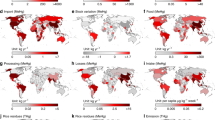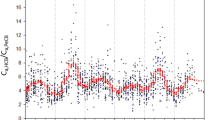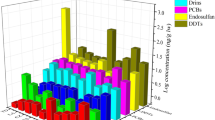Abstract
International food trade poses food safety risks through the collateral transport of contaminants that are harmful to human health. Persistent organic pollutants, such as the polychlorinated biphenyl (PCB) congener PCB-153, are consumed via fish intake traded globally, but the estimated daily intake and risk to human health are poorly understood. Using a food trade pathway model, a global-scale atmospheric persistent organic pollutant transport model and UN Global Comtrade data, high PCB exposure was identified in Western Europe. Marine fish exported from Europe to Sub-Saharan African countries account for 84% of PCB-153 consumer exposure. In contrast, European fish consumers face reduced exposure to PCB-153 by consuming marine fish imported from countries where PCB-153 concentrations are low. People consuming aquaculture-farmed salmon fed with marine ingredients from PCB-153-contaminated seawaters face a higher PCB exposure. Our findings demonstrate that global fish trade can exacerbate PCB-153 exposure in regions where environmental PCB-153 levels are low. This approach demonstrates how the exposure to harmful food contaminants distributed through global food trade can be predicted and quantified.
This is a preview of subscription content, access via your institution
Access options
Access Nature and 54 other Nature Portfolio journals
Get Nature+, our best-value online-access subscription
$29.99 / 30 days
cancel any time
Subscribe to this journal
Receive 12 digital issues and online access to articles
$119.00 per year
only $9.92 per issue
Buy this article
- Purchase on Springer Link
- Instant access to full article PDF
Prices may be subject to local taxes which are calculated during checkout






Similar content being viewed by others
Data availability
Gridded fish catch data are available at the Sea Around Us (http://www.seaaroundus.org). Global fish trade data are available at UN Comtrade (https://comtrade.un.org). The authors declare that the other data supporting the findings of this study are available within the paper and its Supplementary Information.
Code availability
All datasets and model code generated and/or analysed that support the findings of this study are available from the corresponding author upon request, or on the website of one of our laboratories (http://kleppc.lzu.edu.cn/).
References
Rostami, I. & Juhasz, A. Assessment of persistent organic pollutant (POP) bioavailability and bioaccessibility for human health exposure assessment: a critical review. Crit. Rev. Environ. Sci. Technol. 41, 623–656 (2011).
Batt, A. L., Wathen, J. B., Lazorchak, J. M., Olsen, A. R. & Kincaid, T. M. Statistical survey of persistent organic pollutants: risk estimations to humans and wildlife through consumption of fish from US rivers. Environ. Sci. Technol. 51, 3021–3031 (2017).
Batool, S. et al. Geographical distribution of persistent organic pollutants in the environment: a review. J. Environ. Biol. 37, 1125–1134 (2016).
AMAP Assessment 2018: Biological Effects of Contaminants on Arctic Wildlife and Fish (Arctic Monitoring and Assessment Programme, 2018).
Guo, W. et al. Persistent organic pollutants in food: contamination sources, health effects and detection methods. Int. J. Environ. Res. Public Health 16, 4316 (2019).
Gascón, M. et al. Effects of persistent organic pollutants on the developing respiratory and immune systems: a systematic review. Environ. Int. 52, 51–65 (2013).
Ng, C. A. & von Goetz, N. The global food system as a transport pathway for hazardous chemicals: the missing link between emissions and exposure. Environ. Health Persp. 125, 1–7 (2017).
Breivik, K., Czub, G., McLachlan, M. S. & Wania, F. Towards an understanding of the link between environmental emissions and human body burdens of PCBs using CoZMoMAN. Environ. Int. 36, 85–91 (2010).
Undeman, E., Brown, T. N., McLachlan, M. S. & Wania, F. Who in the world is most exposed to polychlorinated biphenyls? Using models to identify highly exposed populations. Environ. Res. Lett. 13, 064036 (2018).
Faroon, O. & Ruiz, P. Polychlorinated biphenyls: new evidence from the last decade. Toxicol. Ind. Health 32, 1825–1847 (2016).
Mackay, D., Shiu, W. Y., Ma, K. C. & Lee, S. C. Handbook of Physical–Chemical Properties and Environmental Fate for Organic Chemicals (CRC, 2006).
Sethajintanin, D., Johnson, E. R., Loper, B. R. & Anderson, K. A. Bioaccumulation profiles of chemical contamination in fish from the Lower Willamette River, Portland Harbour, Oregon. Environ. Contam. Toxicol. 46, 114–123 (2004).
Breivik, K., Sweetman, A., Pacyna, J. M. K. & Jones, C. Towards a global historical emission inventory for selected PCB congeners — a mass balance approach. 1. Global production and consumption. Sci. Total Environ. 290, 181–198 (2002).
Breivik, K., Sweetman, A., Pacyna, J. M. K. & Jones, C. Towards a global historical emission inventory for selected PCB congeners — a mass balance approach. 3. An update. Sci. Total Environ. 377, 296–307 (2007).
Breivik, K., Armitage, J. M., Wania, F., Sweetman, A. & Jones, K. C. Tracking the global distribution of persistent organic pollutants accounting for E-waste exports to developing regions. Environ. Sci. Technol. 50, 798–805 (2016).
Undeman, E., Brown, T. N., Wania, F. & McLachlan, M. S. Susceptibility of human populations to environmental exposure to organic contaminants. Environ. Sci. Technol. 44, 6249–6255 (2010).
Kong, D., MacLeod, M., Hung, H. & Cousins, I. T. Statistical analysis of long-term monitoring data for persistent organic pollutants in the atmosphere at 20 monitoring stations broadly indicates declining concentrations. Environ. Sci. Technol. 48, 12492–12499 (2014).
The State of World Fisheries and Aquaculture 2018 (FAO, 2018); http://www.fao.org/3/I9540EN/i9540en.pdf
Hites, R. A. et al. Global assessment of organic contaminants in farmed salmon. Science 303, 226–229 (2004).
Asche, F., Roll, K. H., Sandold, H. N., Dengjun, A. S. & Zhang, D. Salmon aquaculture: large companies and increased production. Aquac. Econ. Manag. 17, 322–339 (2013).
Salmon Farming Industry Handbook 2018 (Marine Harvest ASA, 2018); http://hugin.info/209/R/2200061/853178.pdf
Responsible Sourcing Guide: Farmed Atlantic Salmon (Seafish, 2015); https://www.seafish.org/media/1403303/_2_atlantic_salmon_rsg_-_cocker_04-15kg.pdf
Globefish Highlights 2014 (FAO, 2015); http://www.fao.org/3/a-bc008e.pdf
Knapp, G., Roheim, C. A. & Anderson, J. L. The Great Salmon Run: Competition Between Wild and Farmed Salmon (TRAFFIC North America, 2007); https://www.traffic.org/site/assets/files/3637/great-salmon-run.pdf
Carlson, D. L. & Hites, R. A. Polychlorinated biphenyls in salmon and salmon feed: global differences and bioaccumulation. Environ. Sci. Technol. 39, 7389–7395 (2005).
Bell, J. G. et al. Complete replacement of fish oil with a blend of vegetable oils affects dioxin, dioxin-like polychlorinated biphenyls (PCBs) and polybrominated diphenyl ethers (PBDEs) in 3 Atlantic salmon (Salmo salar) families differing in flesh adiposity. Aquaculture 324–325, 118–126 (2012).
Berntssen, M. H. G., Lundebye, A. & Torstensen, B. E. Reducing the levels of dioxins and dioxin-like PCBs in farmed Atlantic salmon by substitution of fish oil with vegetable oil in the feed. Aquac. Nutr. 11, 219–231 (2005).
Buzby, J. C. International Trade and Food Safety: Economic Theory and Case Studies (USDA, 2003); https://arefiles.ucdavis.edu//uploads/filer_public/2014/05/19/lcfoodsafettrade03.pdf
Pesticide Residues in Food – Fact Sheet (WHO, 2018); http://www.who.int/mediacentre/factsheets/pesticide-residues-food/en
Workshop on Pesticide Maximum Residue Levels (MRLS): Recommendation for Endorsement by SPS Committee (WTO, 2017); https://docs.wto.org/dol2fe/Pages/SS/directdoc.aspx?filename=q:/G/SPS/W292R2.pdf
Montory, M. & Barra, R. Preliminary data on polybrominated diphenyl ethers (PBDEs) in farmed fish tissues (Salmo salar) and fish feed in Southern Chile. Chemosphere 63, 1252–1260 (2006).
NRC Exposure Science in the 21st Century: A Vision and a Strategy (National Academies Press, 2012).
Ma, J., Daggupaty, S., Harner, T. & Li, Y. Impacts of lindane usage in the Canadian prairies on the Great Lakes ecosystem. 1. Coupled atmospheric transport model and modeled concentrations in air and soil. Environ. Sci. Technol. 37, 3774–3781 (2003).
Zhang, L., Ma, J., Venkatesh, S., Li, Y. & Cheung, P. Modeling evidence of episodic intercontinental long-range Mackay transport of lindane. Environ. Sci. Technol. 42, 8791–8797 (2008).
Ma, J., Daggupaty, S. M., Harner, T., Pierrette, P. & Waite, D. Impacts of lindane usage in the Canadian prairies on the Great Lakes ecosystem. 2. Modeled dry, wet depositions and net gas exchange fluxes, and loadings to the Great Lakes. Environ. Sci. Technol. 38, 984–990 (2004).
Wallberg, P. & Andersson, A. Transfer of carbon and a polychlorinated biphenyl through the pelagic microbial food web in a coastal ecosystem. Environ. Toxicol. Chem. 19, 827–835 (2000).
Mackay, D. Multimedia Environmental Models: The Fugacity Approach 2nd edn (CRC, 2001).
Vermeulen, N. P. Fish bioaccumulation and biomarkers in environmental risk assessment: a review. Environ. Toxicol. Pharmacol. 13, 57–149 (2003).
Taffi, M., Paoletti, N., Liò, P., Pucciarelli, S. & Marini, M. Bioaccumulation modelling and sensitivity analysis for discovering key players in contaminated food webs: the case study of PCBs in the Adriatic Sea. Ecol. Model. 306, 205–215 (2015).
Gobas, F. A. P. C. J. & Arnot, A. Food web bioaccumulation model for polychlorinated biphenyls in San Francisco Bay, California, USA. Environ. Toxicol. Chem. 29, 1385–1395 (2010).
Tolosa, I. et al. PCBs in the western Mediterranean. Temporal trends and mass balance assessment. Deep-Sea Res. II 44, 907–928 (1997).
Boesch, D. F. et al. Marine Pollution in the United States (Pew Oceans Commission, 2001).
Preston, M. R. The interchange of pollutants between the atmosphere and oceans. Mar. Pollut. Bull. 24, 477–483 (1992).
Melymuk, L. et al. From the city to the lake: loadings of PCBs, PBDEs, PAHs and PCMs from Toronto to Lake Ontario. Environ. Sci. Technol. 48, 3732–3741 (2014).
Huang, T. et al. Trend of cancer risk of Chinese inhabitants to dioxins due to changes in dietary patterns: 1980–2009. Sci. Rep. 6, 21997 (2016).
Breivik, K., Sweetman, A., Pacyna, J. M. & Jones, K. C. Towards a global historical emission inventory for selected PCB congeners — a mass balance approach 2. Emission. Sci. Total Environ. 290, 199–224 (2002).
Wöhrnschimmel, H., Macleod, M. & Hungerbuhler, K. Emissions, fate and transport of persistent organic pollutants to the Arctic in a changing global climate. Environ. Sci. Technol. 47, 2323–2330 (2013).
Devine, B. J. Gentamicin therapy. Drug Intell. Clin. Pharmacol. 8, 650–655 (1974).
Acknowledgements
We thank F. Wania for his detailed and constructive internal review, D. Carpenter for useful discussions, G. Tsui for providing gridded production data for various marine fish by country from the Sea Around Us, and H. Hung and H. Dryfhout-Clark for providing Integrated Atmospheric Deposition Network and Arctic sampling data. We also acknowledge the free use of global historical PCB emission data from the Norwegian Institute for Air Research and many research institutions contributing sampling data to the OSPAR Commission where we collected sampled data for model evaluation. This work was supported by the National Key R&D Program of China (2017YFC0212002), and the National Natural Science Foundation of China (grants 4187750, U1806207 and 41671460).
Author information
Authors and Affiliations
Contributions
J.M. and T.H. designed the study. T.H. performed model simulations. T.H. and W.J. coded the marine food-web model. Z.L., S.S. and W.J. collected the data used in the food-web model. T.H., S.S., Z.L., Y.Z., L.Z., C.G. and X.M. collected the global marine trade data. T.H., S.S., L.C. and K.C. collected the measured data to validate the model. T.H., J.M. and R.W.M. analysed the data, interpreted the results and drafted the manuscript. T.H., J.M., H.G., C.T., S.T. and Z.X. participated in the acquisition, analysis and interpretation of data.
Corresponding author
Ethics declarations
Competing interests
The authors declare no competing interests.
Additional information
Publisher’s note Springer Nature remains neutral with regard to jurisdictional claims in published maps and institutional affiliations.
Extended data
Extended Data Fig. 1 Modeled concentrations (for 2012) of PCB-153.
a, Atmospheric gas (pg m−3), b, atmospheric particle phase (pg m−3), c, water (ng L−1), and d, sediment (ng g−1 ww).
Extended Data Fig. 2 Modeled PCB-153 concentrations in marine fish (ng g−1 ww) for various categories.
a, Total fish, b, anchovies, c, herring-likes, d, cod-likes, e, flatfish, f, salmon, g, tuna & billfish, and h, other fishes.
Extended Data Fig. 3 The map of 14 regions regrouped from countries involved in the global fish trade.
The map provides a key to the color scheme.
Extended Data Fig. 4 Global production (tonnes/cell) for selected marine fish at a 1° longitude by 1° latitude resolution in 2012.
a, Total fish. b, Anchovies. c, Herring-like fish. d, Cod-like fish. e, Flatfish. f, Salmon. g, Tuna and billfish. h, Other fishes.
Extended Data Fig. 5 Exports of various marine fish categories (1000 tonnes) through global trade in 2012.
The color shading in each region indicates the total export of marine fish. The width of the arrows represents the relative marine fish exports ≥ 1000 tonnes for anchovies (b), ≥ 10,000 tons for herring-like (c), cod-like (d), flatfish (e), salmon (f), and tuna & billfish (g), and ≥ 100,000 tons for total fishes (a) and other fishes (h) in 2012.
Extended Data Fig. 6 Difference of EDI between Trade and NO-Trade model runs.
The difference is estimated by EDIDF = EDIT-EDINT, referred to as Trade and NO-Trade simulated EDI, which is equivalent to the intake due to consumption of fish acquired through global trade.
Extended Data Fig. 7 Interregional EDI transfers embodied in the global marine fish trade illustrated as a Circos type graph.
Numbers in brackets indicate EDIs of PCB-153 in each region (Extended Data Fig. 3). The width of each band represents the magnitude of EDI and the band color represents the net inflow of EDI. The colors of outer circular rings correspond to the regions marked.
Extended Data Fig. 8 Percent change between 2003 and 2012.
a, Marine fish imported and b, marine fish exported for various countries and regions. Percent was calculated as (I2012 – I2003)/I2003×100, where I2012 and I2003 are marine fish imported or exported in 2012 and 2003.
Extended Data Fig. 9 Production (tonnes, bars) and percentage (pie chart) of farmed Atlantic salmon by countries.
Farmed Atlantic salmon production in 2012 from 9 countries (red bars) and their respective contribution to global total farmed salmon production (%, pie chart).
Extended Data Fig. 10 Export of Atlantic salmon from major countries with salmonid aquaculture (tonnes).
a, Norway, b, Chile, c, UK, and d, Canada. The colors in the ring chart represent the percentage of Atlantic salmon produced and exported from these 4 countries to those countries importing Atlantic salmon.
Supplementary information
Supplementary Information
Supplementary Figs. 1–10, Tables 1–9 and Notes 1–8.
Supplementary Data 1
Species name, lipid content, weight and diet composition represented in the global marine food web.
Supplementary Data 2
Comparisons between modelled and measured PCB-153 concentrations in air, water, sediment and fish.
Rights and permissions
About this article
Cite this article
Huang, T., Ling, Z., Ma, J. et al. Human exposure to polychlorinated biphenyls embodied in global fish trade. Nat Food 1, 292–300 (2020). https://doi.org/10.1038/s43016-020-0066-1
Received:
Accepted:
Published:
Issue Date:
DOI: https://doi.org/10.1038/s43016-020-0066-1
This article is cited by
-
Dermal Uptake is an Important Pathway for the Bioconcentration of Hydrophobic Organic Compounds by Zebrafish (Danio rerio)
Bulletin of Environmental Contamination and Toxicology (2023)
-
Health and environmental consequences of crop residue burning correlated with increasing crop yields midst India’s Green Revolution
npj Climate and Atmospheric Science (2022)
-
Exposure sources of polychlorinated biphenyls (PCBs) and health risk assessment: a systematic review in Iran
Environmental Science and Pollution Research (2022)
-
Toxic chemical exposure from global fish trade
Nature Food (2020)



